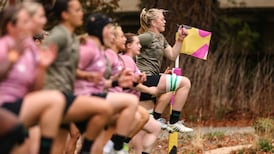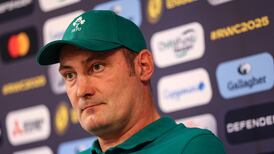Relying on bare statistics to inform any post-match analysis generally doesn't convey the full picture and can, at times, be slightly misleading or lacking in nuance. Take for example those governing the lineout during Leinster's 27-25 Pro14 victory over Munster at the Aviva stadium last weekend.
Leinster lost three of 11 lineouts (a 72 per cent success rate) while their opponents produced a flawless performance in this facet of the game by claiming all 13 on throw. Robin McBryde admitted earlier in the week that "it was the lineout where we didn't get the platform right for our backs to attack from.
"It's not as if we didn't know about [Peter] O'Mahony and how big a threat he is aerially. We didn't deal with it very well. That's definitely made it easier to see where our priorities should lie in building up for Ulster. "
The Leinster forwards' coach was correct in asserting that it was an unstable platform numbers-wise, but two of Leinster's three tries on the day originated from a lineout. Garry Ringrose's clever footwork and break, cutting back against the grain, served as a preamble to a Leinster penalty which Johnny Sexton kicked to the corner.
Hooker Ronan Kelleher hit Jack Conan and Cian Healy eventually broke from the driving maul to insinuate his way under a couple of goal-line defenders to touch down. The second occasion was just before the interval, although this one owed a fair bit to a dollop of good fortune.
Munster’s Peter O’Mahony looked like he had stolen Kelleher’s throw intended for Caelan Doris but, an instant after both players had returned to terra firma, Leinster flanker Josh van der Flier was breaking around the blindside of the ruck. Conan and Healy rumbled forward before Robbie Henshaw’s beautifully judged grubber kick allowed Ringrose to win the race for the ball and dot down.
So, statistically speaking, Leinster’s lineout misfired, yet it was the platform that was central to just over half – 14 points – of the team’s total.
Effective
Johann van Graan’s Munster team boasts the most effective lineout in the Pro14, according to the official statistics, winning 163 of 178 for a 91 per cent success rate, while 18 steals represents the third best behind category leaders Connacht (25), with Leo Cullen’s squad ranked fourth overall, out of touch.
The fact that Munster possesses the best functioning lineout in the Pro14 also provides a bit of perspective on Leinster’s shortcomings on the day, although McBryde’s point still pertains if the lineouts lost were down to a system failure or its component parts: call, movement, throw, lift.
Leinster's other try also came off a set-piece initially, this time a scrum, and following a quick ruck, Sexton's superbly timed pass set Ryan Baird free, who in turn released James Lowe.
If Leinster’s try-scoring access was attributable to the set-piece, Munster’s was a little more fluent in orientation, working their opportunities with patience and precision in pummelling their opponents within a 10-metre channel of rucks and sucking in defenders, before identifying the space and numerical advantage out wide, both of which were hallmarks of Andrew Conway’s tries. For a first game in 170 days, Munster’s rhythm in attack was impressive at times.
The third try did have a lineout as a starter play facilitated initially by Devin Toner’s yellow card, a legacy of previous team transgressions in interfering with the jumper. Munster kicked the penalty to the corner, worked the ball infield initially before it was switched back to the near touchline; Keith Earls’s acceleration, spatial awareness and power allowing him to finish smartly.
The injuries to RG Snyman and Jean Kleyn are unfortunate, but by the time the current season concludes van Graan will know a great deal more about his secondrow resources. Tadhg Beirne should return for Sunday's game against Connacht.
Prowess
It's a real pity that Gavin Thornbury won't get a chance to test his lineout prowess – he has the second most individual steals in the tournament – against the Munster unit. Connacht coach Andy Friend had already committed to completely changing his team at the weekend to give as many squad members an opportunity in these two matches, so Thornbury would not have played even if he hadn't suffered a concussion.
The Dublin-born lock has been very unfortunate with injury and, if he can manage an unencumbered run, has the necessary other qualities to contend for a place in Andy Farrell's Ireland squad. Thornbury is athletic, mobile and possesses good hands.
Ulster will be without Iain Henderson and Alan O'Connor – who suffered a concussion against Connacht – for the Leinster game, but Wallaby Sam Carter, who came on the last day, is a decent replacement. Dan McFarland was critical of his team's performance and that unhappiness would have extended to the lineout where Ulster lost four of 15 throws.
When Leinster and Ulster meet at the Aviva Stadium on Saturday night (7.35) the two lineouts that were less effective numbers-wise – Munster and Connacht had a 100 per cent return respectively on the opening weekend – will be hoping to improve those stats. But arguably what’s more relevant is to note what role the lineout plays in the accumulation of points.













